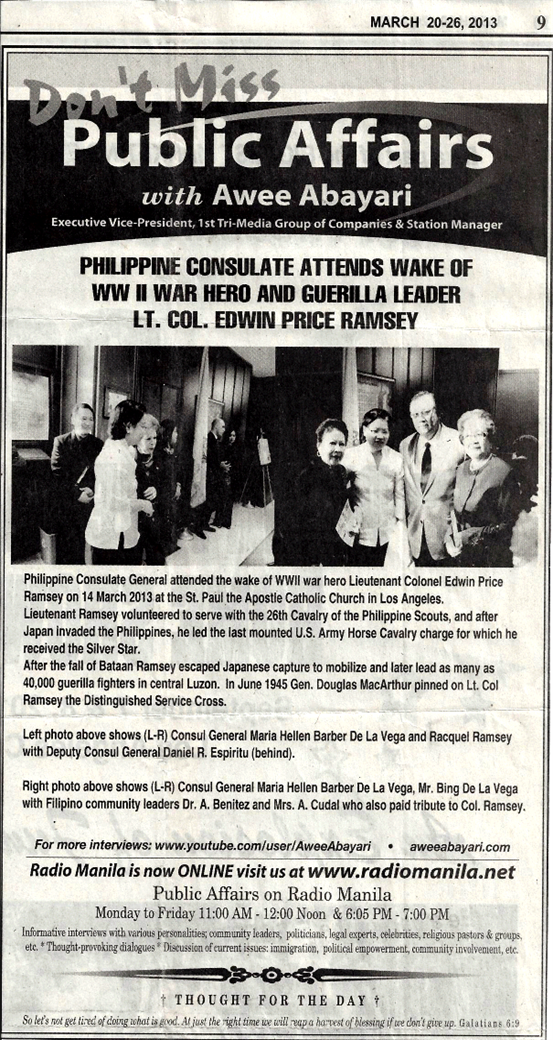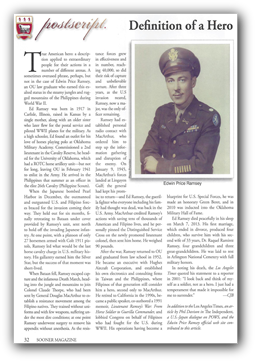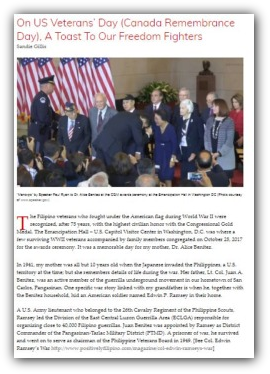Leader of last WWII U.S. cavalry charge dies
INQUIRER.net US Bureau
4:21 am | Saturday, March 16th, 2013
LOS ANGELES – An era in U.S. military history came to a close last week with the death on March 7 of Colonel Edwin Ramsey in Los Angeles, Calif. Ramsey led the last horse-mounted cavalry charge in the history of the United States Army.
On January 16, 1942, Ramsey led a troop of the 26th Mounted Cavalry Regiment in a successful attack on the Japanese-held town of Morong on the West Coast of Bataan. He will be buried in Arlington National Cemetery.
At the time of his death Ramsey was 95 years old. He had been active personally and in veterans’ affairs right up until the end. His comrades-in-arms call Colonel Ramsey “a true American hero.”
Lieutenant Colonel Edwin Price Ramsey was a first lieutenant in the United States Cavalry at the beginning of World War II, stationed in the Philippines. When the U.S. forces on Bataan surrendered to the Japanese, Ramsey refused to give up and escaped into the jungle where, over the next three years, he organized Filipino guerrilla forces that eventually numbered 40,000 fighters.
He was hunted down by the Imperial Japanese Army and by the communist Huk guerrillas, but he managed to escape each time they drew near. At one point during his years in the jungle he was deathly ill and had his appendix removed by a Filipino doctor who used a pocketknife and no anesthesia.
General Douglas MacArthur personally awarded Ramsey the Distinguished Service Cross, Silver Star and Purple Heart for the success of his guerrilla organization, his heroism and his combat wounds.
After the war Ramsey returned to the United States, then spent five years in Japan as an executive with Hughes Aircraft Corporation, and more years in the Philippines as a private businessman before he retired in California.
He has been honored by presidents and recognized by the U.S. Army’s Special Forces, which to a large degree are modeled after Ramsey’s guerrilla organization in World War II. His wartime exploits are preserved in the book Lieutenant Ramsey’s War and the documentary film “Forgotten Soldiers.”
Read More

About the following, Raqui writes: "This is part of the article that Awee Abayari, Executive VP and Station Manager of Radio Manila sent to me from Tri-Media Group of Companies on the participation of the Philippine Consulate General Maria Hellen Barber de La Vega as seen in the photo with me and Deputy Consul General Daniel Espiritu behind us at Ed’s funeral mass and Memorial Service on March 14, 2013 at St. Paul the Apostle Catholic Church."
The August 2013 issue of Hui O Na Koa, the newsletter of the Hawaii State Chapter of the Military Officers Association of America, included a eulogy for Ed written by Stephen J. Rivele, co-author of "Lieutenant Ramsey's War". The excerpt of the newletter contains that eulogy.
Please click the image to see the full newsletter.
Additional Links:
The Oct 31, 2013 issue of the Beverly Hills Weekly included an article showcasing the new display honoring Ed at the Beverly Hills Library.
Download the article
The Summer 2013 issue of OU Sooner magazine contained an article on Ed by Carol Burr entitled, "Definition of a Hero".
Download the article
See the full issue on the OU Foundation site

IN AFGHANISTAN: For rebels, horses are a big part of battle
November 9, 2001
BY CALVIN WOODWARD
ASSOCIATED PRESS
WASHINGTON -- More than half a century after the U.S. Army gave up on four-legged warfare, Americans are supplying horse feed to Afghan rebels and watching them ride their steeds toward battle.
"The best vehicle they've got is a horse," said Edwin Price Ramsey, believed to be the last man to lead a U.S. cavalry charge -- against Japanese forces in the Philippines in 1942. As vaguely described Wednesday by Pentagon spokesman Gen. Peter Pace, rebels have been seen "riding horseback into combat against tanks and armored personnel carriers," their horses fed and watered with U.S. help.
An expert on Afghan fighting tactics, however, says anyone who believes rebels are charging tank columns on horses has not been to Afghanistan. "They don't fight on horseback, but the horse is vital for supplies and mobility," said David Isby, who wrote a book on weapons and strategy in the Soviet-Afghan war. "The horse is better than a four-wheel drive."
Sharif Ghalib, a counselor at the Afghan mission to the United Nations, where his country is represented by the anti-Taliban opposition, said about 600 fighters are on horseback."It shows a traditional way of doing things," he said from New York. But also, he said, those fighters are on horses because they don't have anything else.
Afghans also fought at a disadvantage against modern Soviet weapons early in that war. On at least one occasion, they used horses to raid Russian border troops, Isby said. Next to helicopters, horses are the second best way to get fighters and supplies to the front in mountainous terrain, Isby said. But neither he nor Ramsey thought a frontal cavalry assault on Taliban tanks or artillery was in the cards.
"You wouldn't charge a tank. That would be stupid," Ramsey, 84, said by phone from Los Angeles. But on certain ground, a mounted fighter can make trouble. "We had a few people who crawled up the back of tanks in the middle of a fight and put grenades into them."
Ramsey described a hurriedly organized charge by members of his 26th Cavalry platoon on Jan. 16, 1942 — 27 men firing pistols from their saddles in a headlong raid against an advance guard of Japanese infantry and artillery.
In hospital with a mortar wound, he learned the horses had been slaughtered for hungry soldiers.
Soon, the Philippines fell to Japan, U.S. soldiers surrendered there en masse and died by the thousands during the Bataan Death March. Ramsey escaped.
View AP Article as seen in the San Diego Tribune



Click the image below to download two pages from the Philippine Media Los Angeles edition containing mention of Ed's book and the 28th Philippine-American Exposition held in LA.
The Summer 2013 issue of The Quan, the newsletter of the The American Defenders of Bataan & Corregidor, included a eulogy for Ed and a write-up of The Last Charge.
Please click the image to see the full newsletter.
The October 2008 issue of Western Shooting Horse magazine included an article entitled "Parting Shot - The Last Cavalry Charge in US History".
Download the article
2014 Press release via Radio Manila station manager Awee Abayari.
2016 Press release via Radio Manila station manager Awee Abayari.
Sandie Gillis wrote an article entitled "Col. Edwin Ramsey's War" for the February 8, 2017 issue of Positively Filipino magazine.
See the complete article here
Article by Jay Wertz, who is an author of two WWII books and appeared in Never Surrender. The article appeared in the January 11, 2017 release of Radio Manila Worldwide.
Another wonderful article by Sandie Gillis entitled "On US Veterans’ Day (Canada Remembrance Day), A Toast To Our Freedom Fighters" for the November 15, 2017 issue of Positively Filipino magazine.
See the complete article here




